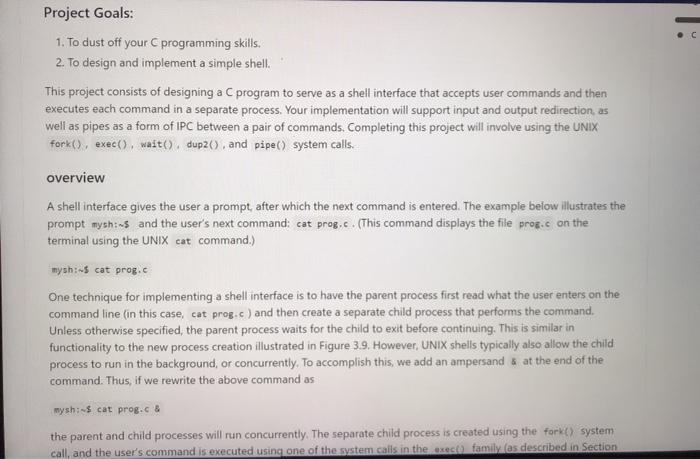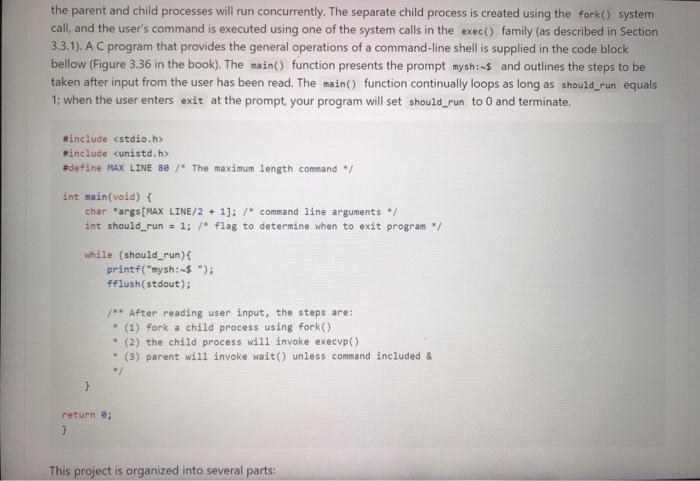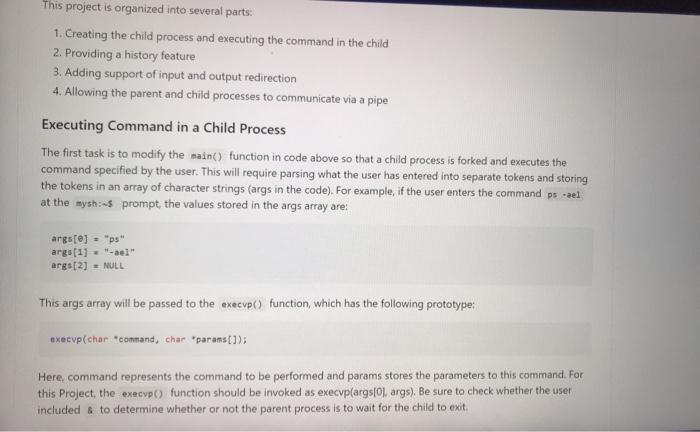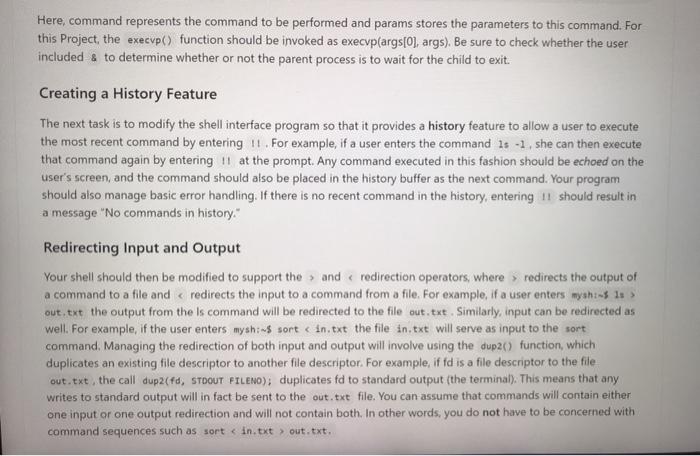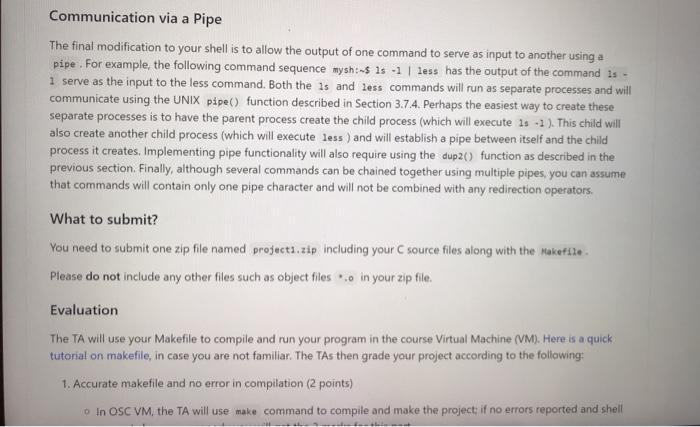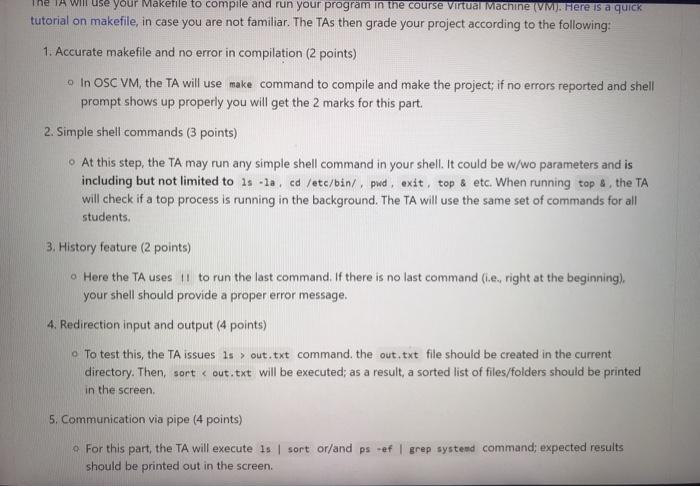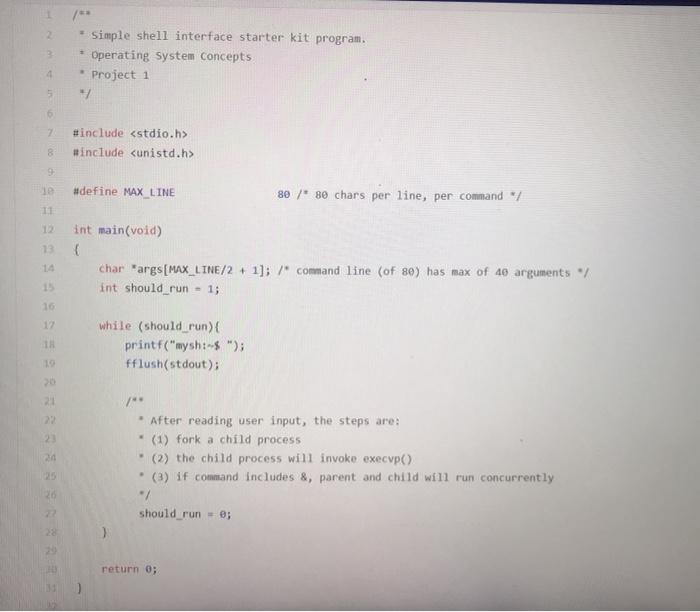Project Goals: 1. To dust off your C programming skills. 2. To design and implement a simple shell. This project consists of designing a C program to serve as a shell interface that accepts user commands and then executes each command in a separate process. Your implementation will support input and output redirection, as well as pipes as a form of IPC between a pair of commands. Completing this project will involve using the UNIX fork(), exec(), wait(), dup2(), and pipe() system calls. overview A shell interface gives the user a prompt after which the next command is entered. The example below illustrates the prompt myshims and the user's next command: cat prog.c. (This command displays the file prop.c on the terminal using the UNIX cat command.) mysh:-5 cat prog.c One technique for implementing a shell interface is to have the parent process first read what the user enters on the command line (in this case, cat prog.c) and then create a separate child process that performs the command. Unless otherwise specified, the parent process waits for the child to exit before continuing. This is similar in functionality to the new process creation illustrated in Figure 3.9. However, UNIX shells typically also allow the child process to run in the background, or concurrently. To accomplish this, we add an ampersand & at the end of the command. Thus, if we rewrite the above command as mysh:$ cat prog.c & the parent and child processes will run concurrently. The separate child process is created using the fork() system call, and the user's command is executed using one of the system calls in the exec(family las described in Section the parent and child processes will run concurrently. The separate child process is created using the fork() system call, and the user's command is executed using one of the system calls in the exec() family (as described in Section 3.3.1). A program that provides the general operations of a command-line shell is supplied in the code block bellow (Figure 3.36 in the book). The main() function presents the prompt mysh:-s and outlines the steps to be taken after input from the user has been read. The main() function continually loops as long as should_run equals 1; when the user enters exit at the prompt, your program will set should run to 0 and terminate. #include
#include #define MAX LINE 80 / The maximum length command int main(void) { char *args[MAX LINE/2 + 1]; /* command line arguments / int should run = 1; /* flag to determine when to exit program/ while (should run) { printf("mysh:-5 "); Fflush(stdout); /** After reading user input, the steps are: - (1) fork a child process using fork) (2) the child process will invoke execvp() (3) parent will invoke wait() unless command included & " } return; This project is organized into several parts: This project is organized into several parts: 1. Creating the child process and executing the command in the child 2. Providing a history feature 3. Adding support of input and output redirection 4. Allowing the parent and child processes to communicate via a pipe Executing Command in a Child Process The first task is to modify the main() function in code above so that a child process is forked and executes the command specified by the user. This will require parsing what the user has entered into separate tokens and storing the tokens in an array of character strings (args in the code). For example, if the user enters the command ps -ael at the mysh:-$ prompt, the values stored in the args array are: args[e] = "ps" args[1] = "-ael" args[2) = NULL This args array will be passed to the execvp() function, which has the following prototype: execup(char command, char 'params[]); Here, command represents the command to be performed and params stores the parameters to this command. For this Project, the execvp() function should be invoked as execup(args[0] args). Be sure to check whether the user included & to determine whether or not the parent process is to wait for the child to exit Here, command represents the command to be performed and params stores the parameters to this command. For this Project, the execup() function should be invoked as execvp(args[0], args). Be sure to check whether the user included & to determine whether or not the parent process is to wait for the child to exit. Creating a History Feature The next task is to modify the shell interface program so that it provides a history feature to allow a user to execute the most recent command by entering 11. For example, if a user enters the command is -1, she can then execute that command again by entering 11 at the prompt. Any command executed in this fashion should be echoed on the user's screen, and the command should also be placed in the history buffer as the next command. Your program should also manage basic error handling. If there is no recent command in the history, entering 11 should result in a message "No commands in history." Redirecting Input and Output Your shell should then be modified to support the > and redirects the output of a command to a file and out.txt. Communication via a Pipe The final modification to your shell is to allow the output of one command to serve as input to another using a pipe. For example, the following command sequence mysh:~$ ls -1 | less has the output of the command is 1 serve as the input to the less command. Both the is and less commands will run as separate processes and will communicate using the UNIX pipe() function described in Section 3.7.4. Perhaps the easiest way to create these separate processes is to have the parent process create the child process (which will execute 15 -1). This child will also create another child process (which will execute less ) and will establish a pipe between itself and the child process it creates. Implementing pipe functionality will also require using the dup2() function as described in the previous section. Finally, although several commands can be chained together using multiple pipes, you can assume that commands will contain only one pipe character and will not be combined with any redirection operators What to submit? You need to submit one zip file named projects.zip including your source files along with the Makefile: Please do not include any other files such as object files in your zip file. Evaluation The Ta will use your Makefile to compile and run your program in the course Virtual Machine (VM). Here is a quick tutorial on makefile, in case you are not familiar. The TAs then grade your project according to the following: 1. Accurate makefile and no error in compilation (2 points) o In OSC VM, the TA will use make command to compile and make the project if no errors reported and shell The A Will use your Makefile to compile and run your program in the course Virtual Machine (VM. Here is a quick tutorial on makefile, in case you are not familiar. The TAs then grade your project according to the following: 1. Accurate makefile and no error in compilation (2 points) In OSC VM, the TA will use make command to compile and make the project; if no errors reported and shell prompt shows up properly you will get the 2 marks for this part. 2. Simple shell commands (3 points) At this step, the TA may run any simple shell command in your shell. It could be w/wo parameters and is including but not limited to ls -la, cd /etc/bin/. pwd. exit, top & etc. When running top & the TA will check if a top process is running in the background. The TA will use the same set of commands for all students. 3. History feature (2 points) Here the TA uses 11 to run the last command. If there is no last command (ie right at the beginning), your shell should provide a proper error message. 4. Redirection input and output (4 points) - To test this, the TA issues 1: > out.txt command the out.txt file should be created in the current directory. Then, sort out.txt will be executed as a result, a sorted list of files/folders should be printed in the screen 5. Communication via pipe (4 points) For this part, the TA will execute is sort or/and ps -ef | grep systend command; expected results should be printed out in the screen. /** - Simple shell interface starter kit program. Operating system Concepts Project 1 4 2 #include #include 8 #define MAX_LINE 80 / 80 chars per line, per command / 11 12 int main(void) 13 10 15 char *args[MAX_LINE/2 + 1]; /* command line (of 80) has max of 40 arguments / int should run - 1; 10 12 while (should run) printf("mysh:--$"); fflush(stdout); 30 23 22 23 After reading user input, the steps are: - (1) fork a child process (2) the child process will invoke execup() (3) if command includes &, parent and child will run concurrently *7 should run - e; 20 28 return 0
